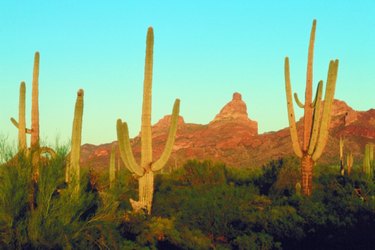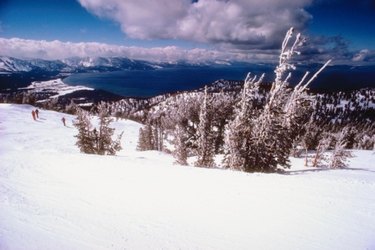
In harsh desert climates or extremely cold climates where little water is available to plants, they must adapt to be able to survive. Xerophytic plants have developed several water-conserving adaptations, like forming thick stems and trunks to store water, having waxy leaves to control evaporation, or having hairy leaves and stems to better catch and keep water. The plant's root systems may be extremely deep to tap deep water reserves, or shallow and widespread to optimize surface moisture collection.
Cactus Family
Video of the Day
When most people think of desert plants, they think of cactus. Most cacti are xerophytic. One of the most famous types of cactus is the saguaro -- a very tall, branching, tree-like cactus that can hold as much as a ton of water. Barrel cactus is a common desert presence and is a round, squat, ball-like plant that is extremely thick. The prickly pear grows in the southwestern United States and Mexico and has oval pads and produces a fruit that is edible and makes a tart jelly. Cholla is a multi-branched, shrub-like cactus that often looks somewhat frosted. All conserve water in their tissues and have shallow widespread roots.
Video of the Day
Yucca Family
Plants of the yucca family are common in deserts. The star of the famous Joshua Tree National Park is the Yucca brevifolia, growing as a large, multi-trunked tree with spear-like foliage. In the Mojave Desert lives the Yucca schidigera, which looks very similar to the Joshua tree. The soaptree yucca (Yucca elata) is so called because the trunk and root contains a substance used by some Native Americans like soap. Yucca baccata has blue-green, spear-like leaves. Yuccas have tough, waxy foliage, and some have deep tap roots.
Desert Trees and Palms
Some tall trees survive well in desert conditions, although most desert plants are small. Palms, like the date palm or doum palm, have thick trunks and leathery, waxy foliage that retain water. Both mesquite, whose wood is prized for barbecues, and acacia, another desert tree, are members of the pea family. Both survive the lack of surface water by tapping into ground water. The chilopsis has beautiful orchid-like flowers and survives because of its deep roots and waxy leaves.
Desert Shrubs
Some fascinating desert shrubs have developed special mechanisms for survival. The creosote bush has a waxy coating on its leaves, plus it absorbs water so efficiently that plants around it can't get enough water to grow, leaving little vegetation surrounding it. The common sagebrush has fine silvery hairs that deflect heat and grab onto water. Additionally, it has a large taproot. The resurrection plant (Selaginella) has the incredible ability to become almost completely dessicated, and amazingly, just a little water revives it.
Arctic Plants

The arctic has conditions that require plants to be xerophytic, since most of the water is locked up in ice most of the year. The cloudberry, a relative of the raspberry, can survive to -40 F because it contains helpful chemical compounds. The Arctic willow creeps along the ground and adapts to the cold by forming a shallow root system and protecting its leaves with long fuzzy hairs. The Labrador tea, a member of the Rhododendron family, has branches covered in brown hairs that protect it from cold.